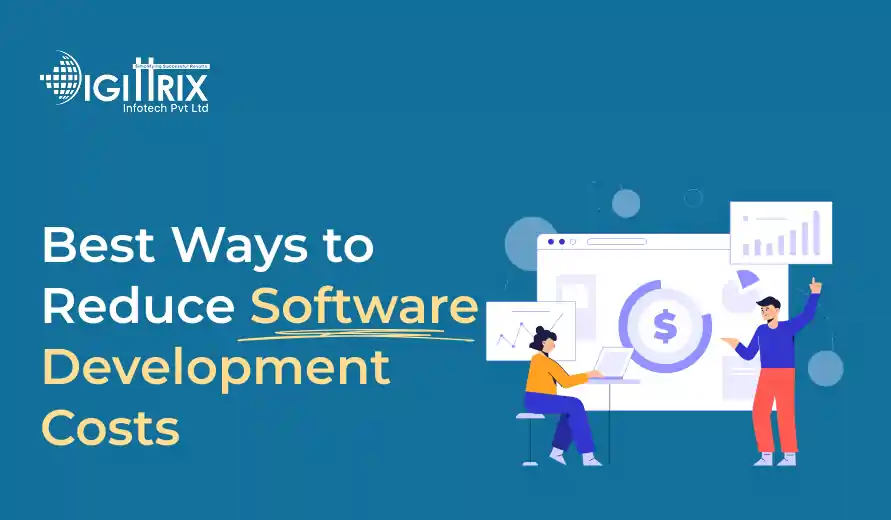Efficient planning, outsourcing, and smart resource management can reduce software development costs by up to 50% while maintaining quality and ensuring timely project delivery.
Highlights
An enthusiastic developer and skilled business management expert with over a decade of experience in the field

Whether it’s an app for customers, an internal tool, or a digital product for sale, software projects can easily go over budget if not managed wisely. Cutting costs in development does not always mean cutting corners or sacrificing quality. It’s about better planning, managing resources efficiently, and making smart decisions from start to finish.
In this article, we will explore practical and tested methods to lower software development costs while ensuring quality and achieving business objectives.
Want to dive into the world of education technology? Check out Digittrix’s comprehensive guide to EdTech software development and see what it takes to build modern learning platforms!
The first and most crucial step to saving money in development is defining clear and detailed project requirements. Many projects fail or go over budget because of vague goals or last-minute adjustments.
Before hiring a software development company, create a written list of your goals, required features, and design expectations. Discuss with your team the problem the software should solve and who will use it. When every detail is outlined early, developers can plan more effectively, reducing confusion and the need for rework later.
Creating a Software Requirement Specification (SRS) document helps everyone stay aligned. It defines the project scope, clarifies functionality, and prevents unnecessary changes during development, which often increase costs.
Many companies spend large sums on features users might never need. Creating an MVP helps you focus only on the most essential features first. This version can be launched quickly and tested with real users. Based on feedback, you can decide later which features are worth investing in.
Developing an MVP assists in:
This approach not only reduces costs but also guarantees your software is focused on actual needs rather than assumptions.
Choosing a reliable software development company can greatly impact your budget. Some businesses opt for the lowest bidder, thinking it will save money. However, hiring inexperienced developers often results in poor-quality code, project delays, and extra costs down the line when issues arise.
Look for a partner with a proven track record, positive client feedback, and expertise in your type of project. Request cost estimates, timelines, and post-launch support terms before signing a contract. A good partner may not be the cheapest, but they save you more money in the long run by doing things right from the start.
For many businesses, outsourcing software development is one of the best ways to manage expenses. Hiring full-time employees involves paying salaries, training costs, and benefits even after the project is finished. With outsourcing, you only pay for the services you need.
Outsourcing also provides access to global talent at competitive prices. For example, companies in India, Eastern Europe, or Southeast Asia offer skilled developers who deliver quality work at a fraction of local costs.
However, to make outsourcing effective, communicate consistently, set realistic milestones, and use project management tools to track progress. When managed properly, this approach can reduce costs by up to 50%.
One of the smartest ways to save money is by using open-source software. These tools are free, dependable, and supported by large developer communities. From content management systems to web frameworks, open-source technologies enable developers to create solid foundations without licensing costs.
For example, using frameworks like React, Django, or Laravel can accelerate development. They include built-in features, which reduce the need to build everything from the ground up. Always make sure that the chosen open-source tool is well-maintained and has an active community for ongoing support.
Many companies neglect scalability early on and end up spending more later to fix issues as their software expands. Proper planning helps you prevent costly rebuilds or restructuring in the future.
When hiring a software developer, ensure they understand how to design scalable architectures. Even if your initial version is small, the system should be able to handle more users, data, or new features in the future. This lowers the risk of major redesigns or data migration costs later on.
Another effective way to reduce development costs is by reusing existing code. Many features are common across projects, such as login systems, payment gateways, or admin dashboards. Using pre-made modules or templates saves both time and effort.
Developers can keep a library of reusable components, which reduces coding effort and testing time. Reusing code also guarantees consistency in performance and reliability across various parts of the project.
Manual testing takes a lot of time and increases labor costs. Automated testing tools help accelerate this process. Automation ensures that every code update is checked for errors immediately, which reduces human involvement and cuts rework expenses.
Similarly, automated deployment allows for the quick and safe release of updates without manual configuration. This method decreases downtime, saves time, and maintains a smooth development process.
Miscommunication among teams, clients, and developers is one of the main causes of cost overruns. Establishing clear communication channels early on helps prevent confusion and delays.
Use tools like Slack, Jira, or Trello for task management. Schedule regular update meetings and encourage developers to report challenges early. Good communication also helps identify potential risks before they become serious problems.
Scope creep involves introducing additional features or modifications that weren't part of the initial plan. Even minor changes can significantly increase costs if they require extra design, coding, and testing.
The key is to follow the approved plan and avoid adding unnecessary elements along the way. If changes are necessary, record them carefully, estimate the new costs, and obtain client approval before moving forward. This maintains accountability and helps keep the project within budget.
Choosing programming languages, databases, and frameworks significantly impacts cost control. Some technologies have higher maintenance or licensing fees, while others may demand specialized skills that are costly to hire.
Discuss with your software development services provider which stack best fits your goals. For example, open-source technologies like Node.js, Python, or PHP can be cost-effective options. Choosing the right stack not only cuts costs but also makes future updates easier.
Cloud computing lets you pay only for the resources you use. Instead of purchasing and managing costly servers, you can host your software on cloud platforms such as AWS, Google Cloud, or Azure.
However, it’s crucial to monitor usage. Many companies end up paying for unused storage or extra features. Regularly review your cloud settings to keep costs in check. This also makes scaling up or down much easier without significant investment in hardware.
Code reviews help identify problems early before they become expensive. When senior developers review the code regularly, they can find logic errors, security gaps, or unnecessary complexity.
Regular reviews help keep code high quality, catch bugs early, and lower later fixing costs. They also motivate developers to produce cleaner, more organized code, making future updates easier.
Many companies only consider maintenance after launch. This can cause unexpected costs when bugs or compatibility problems happen. Planning for maintenance from the beginning lets you allocate part of the budget for regular updates, server upkeep, and security patches.
Discuss maintenance terms with your software development services provider before finalizing the project. A clear post-launch plan helps prevent unexpected costs and maintains your software's stability over time.
Agile development emphasizes delivering projects in smaller, manageable phases known as “sprints.” This approach enables testing, reviewing, and improving the product gradually. With Agile, teams can quickly adapt to changes and identify problems early.
Breaking the work into smaller steps ensures you don’t waste time on large-scale revisions later. It also lets you control expenses after each sprint and adjust priorities as needed.
Sometimes developers become involved in creating complex features or systems that go beyond current needs. This “over-engineering” results in wasted time, effort, and money. Always align your software’s complexity with your business goals and user needs.
Keep things as straightforward as possible to reach your goals. Functionality should always take priority over fancy technology.
Even with the best plans, development costs can still unexpectedly increase. Regular monitoring helps spot when expenses go off track. Use project tracking tools to compare actual costs to the budget.
Hold review meetings at every major milestone. This helps identify inefficiencies and take corrective action early instead of waiting until it’s too late.
Working repeatedly with the same software developer or team offers long-term cost benefits. They understand your business, coding standards, and preferences, which shortens onboarding time for future projects.
Building long-term relationships often result in better pricing and more consistent quality over time. It also helps ensure uniformity across all your software products.
Looking to unlock smarter software solutions? Check out Digittrix’s expert overview on AI & ML in custom software development and stay ahead.
Reducing software development costs isn’t about sacrificing quality; it’s about planning smarter, communicating more clearly, and making thoughtful decisions. From defining clear requirements and selecting the right partner to using open-source tools and conducting regular reviews, each step helps you save time and money.
By following the strategies mentioned above, businesses can develop high-quality software within budget and without stress. The key is smart planning, efficient execution, and maintaining a long-term focus on both quality and cost-efficiency.
For growing businesses, managing software development costs is as important as achieving excellent results. At Digittrix, we specialize in custom software development that helps you maximize value from every investment without sacrificing performance or quality.
Our team recognizes that each business has its own needs. Whether you want to streamline operations, enhance user experience, or grow your digital presence, we provide software development services tailored to your specific goals and budget. From detailed planning to post-launch support, we ensure every step delivers real value to your business.
With over 14 years of experience, Digittrix has supported businesses across industries like healthcare, retail, education, and finance in building reliable software that performs effectively and adapts to their needs. We believe in smart execution; every feature we develop provides genuine value.
Searching for software that meets your goals and budget? Let Digittrix make it happen.
Call us at +91 8727000867 or email digittrix@gmail.com to schedule your free consultation today.

Do you need help in ?




Join over 1500+ businesses we've already helped!
You can reduce costs by planning clearly, using open-source tools, outsourcing development, and building an MVP before the full version.
Yes, outsourcing helps reduce expenses by hiring skilled global talent at affordable rates. It also allows flexibility without long-term hiring costs.
Clear project requirements prevent rework, confusion, and budget overruns. It ensures developers understand the exact goals and deliver efficiently.
Absolutely. Open-source tools are free and widely supported, reducing licensing fees and speeding up development through pre-built components.
By planning for maintenance early, setting a fixed budget, and partnering with a trusted development company for regular updates and support.

©2025Digittrix Infotech Private Limited , All rights reserved.